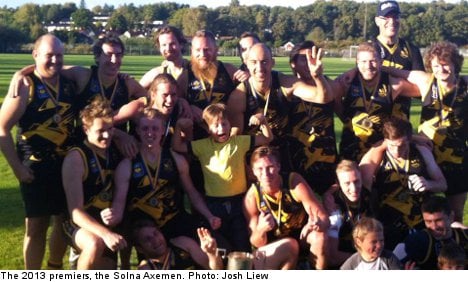On an unseasonably sunny Saturday in Stockholm, the Solna Axemen took on arch rivals, the Södermalm Blues, to claim their third premiership in Sweden’s Australian Rules Football tournament.
The sport (colloquially referred to as Aussie Rules) was exported from Australia and has grown steadily in Sweden over the last decade.
For those who don’t (yet) know, AFL is a team-based, contact sport where sides fight for possession of a rugby-shaped ball, move it to their end of the ground and attempt to score by kicking the ball between a set of four goal posts.
Think of a mixture between rugby and soccer, but on a much bigger field, some measure up to 175 metres long – 60 percent longer than standard international soccer pitches. The physicality and endurance required places a high demand on players.
Players can pass the ball using their fist, can bounce the ball on the ground, and can run in any direction.
Confused? Perhaps a quick video can do more justice:
Ben Kirk, president of the Stockholm-Australian Rules Football Federation (SAFF), believes the game is the best in the world.
“The game itself is probably one of the most athletically challenging,” he told The Local.
“If you look at the professional athletes in Australia that play, they’re big, tall, muscular, able to tackle but they can also run 14 kilometres a game. You need the strength of a wrestler and the stamina to run a marathon.”
When Kirk first arrived in Sweden in 2003, there was no SAFF, no teams… no games for that matter.
“It started off as basically a bunch of guys meeting in Gärdet, kicking a footy around, followed by beers afterwards. It was very much an expat idea at the time, that’s how it started,” he explained.
The Swedes who first found themselves involved were those who had previously ventured “down under” and got a taste for the game (and the beer) as well as the Australian culture.
In fact, the social aspect was one of the primary factors that kept people coming.
“Swedes are lovely, friendly people,” Kirk noted. “All they need is an excuse to start talking.”
As interest grew, so did the number of players and teams. The federation was eventually set up in the hopes of promoting the game in Sweden.
There are currently five teams in the Stockholm area, the Solna Axemen, Årsta Swans, Bromma Vikings, Norrtålje Dockers and lastly the Södermalm Blues. There’s also a regional competition encompassing all of Sweden and a national side aptly named, The Swedish Elks which competes in the AFL International and European Cups once every three years.
“We’ve been going ten years now, its been an organic growth,” said Kirk.
Although the idea did germinate from Australian expats, the Swedish influence is obvious, highlighted by strong participation numbers from Swedes and the continual improvement of the national side.
So what is it that attracts Swedes to AFL?
“Swede’s like the physicality of it,” Kirk responded. “The sort of Swedes it attracts are those that come from a background of handball, ice hockey – those that don’t mind a bit of a bump.”
“But they love it. If they were playing another tackling sport such as NFL or rugby then they don’t quite get the same athleticism.”
And the Swedes are a talented bunch, according to Kirk, something he puts down to good genetics.
“Swedes do make good footballers, if you look at their body types, they’re very mesomorphic, quite strong characters. The stereotypical Scandinavian Vikings would make sensational footballers.”
Although the idea of a Swede playing AFL professionally may seem distant, Kirk remained positive about the possibility.
“It’s bound to happen. There are guys coming through at the moment. As soon as we get a proper training in place, and a juniors’ programme for those in their early teens, then we’ll start to see things happening,” he told The Local.
“It’s only a matter of time, we have enough Swedish-Australian couples procreating,” Kirk said with a laugh.
“But there’s still some some way to go. Next year will be a big one, we’ve got some work to do.”
Josh Liew



 Please whitelist us to continue reading.
Please whitelist us to continue reading.
Member comments